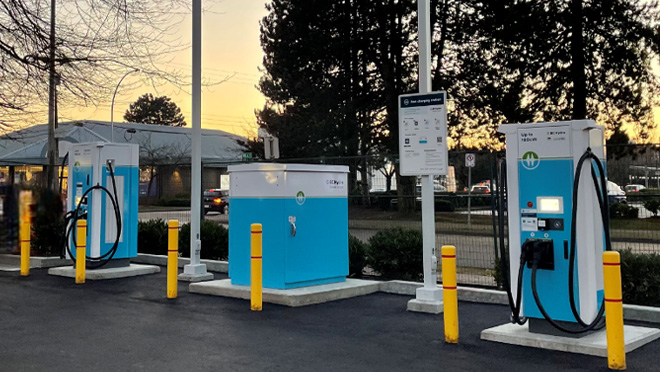 Air-source heat pumps that provide year-round comfort are now commonplace in B.C. homes, thanks in part to our advocacy for emerging technologies and higher efficiency standards.
Air-source heat pumps that provide year-round comfort are now commonplace in B.C. homes, thanks in part to our advocacy for emerging technologies and higher efficiency standards.
Canada’s latest energy efficiency updates, and where they came from
If your home or office has efficient summer cooling via a heat pump, you can thank Canadian electrical utilities for constantly pushing for higher energy efficiency standards for these sorts of equipment.
If you felt relatively warm while standing next to a window during February’s B.C. deep freeze, again you can thank people like Toby Lau, for helping make efficient windows the norm.
Since launching our Power Smart program in the late 1980s, policy specialists and program managers have played a key role in transforming products from niche to mainstream.
"We’re always looking for new technologies and products," says Lau, our principal of codes and standards at BC Hydro. "We work with the standards development organizations to ensure codes and standards continue to evolve."
In April 2025, the federal government introduced its latest energy efficiency requirements and testing standards. They’re expected to come into effect in January 2026 and will cover a range of residential and industrial products, including air conditioners, heat pumps, water heaters, air compressors, pool pumps, faucets, showerheads, and line voltage thermostats.
Pivotal to that standards development is the work of CSA Group and its standards steering committee currently chaired by Lau.
The 2025 standards update is forecasted to deliver 142 gigawatt-hours (GWh) per year in electricity savings in B.C., enough to power 14,000 homes in the province.
Here's how evolving standards transform the market.
"When an energy efficient product is first introduced, the market share might be as low as 10%," says Lau, a Fellow of Engineers Canada who was honoured with CSA Group’s John Jenkins Award in 2023 for his three decades as an advocate for standards in Canada. "Through our incentive programs, we try to increase the market share. Once the market share reaches 60% to 80% of market saturation – that means the energy efficient products are widely available and accepted by customers."
With the market transforming, we work with both provincial and federal governments to develop new energy efficiency regulations that will, once introduced, curb sales of inefficient products. Once those regulations are in place, incentives are no longer required.
"That's when we've reached market transformation," says Lau.
“In B.C., we work closely with the Minister of Energy and Climate Solutions, since the province has its own energy efficiency standards regulation,” says Lau.
“Typically, our standards in B.C. might be higher than the national requirement.” Lau’s proud of how much we’ve influenced the the BC Building Code, the Energy Step Code and Zero Carbon Step Code, and updates to the National Energy Code of Canada for Buildings.
 In addition to releasing an updated handbook earlier this year, The Building Officials Association of BC has released a new series of on-site videos hosted by veteran building officials including Tracy McGuire, a building inspector at the City of Cranbrook.
In addition to releasing an updated handbook earlier this year, The Building Officials Association of BC has released a new series of on-site videos hosted by veteran building officials including Tracy McGuire, a building inspector at the City of Cranbrook.
Q & A with Tyler Wightman on the Handbook for Building Officials
As executive director of the Building Officials Association of British Columbia (BOABC), Tyler Wightman plays a pivotal role in supporting the professionals who ensure our built environment is safe, efficient, and aligned with evolving codes and standards. BOABC represents and certifies building officials – the people responsible for interpreting and enforcing building regulations across municipalities and regions. Their work is essential in turning policy into practice, ensuring that buildings meet not only structural and safety requirements but also today’s ambitious energy performance goals. In recent years, BOABC has helped building officials prepare for the implementation of the BC Energy Step Code. Through training, technical resources, and collaboration, the association has equipped building officials with the knowledge and tools needed to support communities in meeting these standards.
Earlier this year, an updated and expanded BC Energy Step Code and Zero Carbon Step Code Handbook for Building Officials was released. Produced by the BOABC with support from the Government of B.C. and BC Hydro, the guide provides an overview of evolving building codes in B.C. and expands practical information on code compliance and the emergence of high-performance buildings. We sat down with Tyler Wightman to discuss the handbook and BOABC’s role in educating and training building officials on energy codes and standards.
Note that the following Q & A has been edited for brevity and clarity.
Powering Communities: Let’s start with a little background about your role with the BOABC and how you got here.
Tyler Wightman: I joined the BOABC in 2020, but have been involved in provincial building regulation for around 20 years, first with the Government of Alberta, then with the Safety Codes Council. My experience ranges from policy and code development to labour mobility agreements, professional development, examinations, certifications, and training of code officials.
PC: You grew up in Nanaimo and are now back working in B.C. What’s been your primary focus with BOABC?
TW: We’ve been busy setting up a new regulatory regime under the building act, and then doing a lot of structural work on updating credential programs, bylaws and policies, as well as continuing to build out our professional development program, our course offerings for code officials and other stakeholders.
PC: The Handbook for Building Officials was first released in 2019 to support officials in ensuring compliance with the new Energy Step Code. What are the big changes in this update?
TW: The biggest change is the addition of the Zero Carbon Step Code. Changes to code require education of officials to successfully adopt and implement. There’s also more focus on practical examples and not just code knowledge. It explores how you apply that code through permit issuance, insight, and inspection. The working group tried to make it more directly applicable to the work that they do on a day-to-day basis. That’s something we’re trying to do with all our training – the application and interpretation of the code.
PC: Who was involved in the review process, and who’s the core audience for this handbook?
TW: It wasn't a guide that was developed solely by code officials. Energy advisors, home builders and others contributed to it, so that represents input and feedback from a broader cross-section in the industry. I always think it’s important that guidance directed at a code official audience includes perspective from the builder community and the energy advisor community. We’re trying to line up and generate consistency, not just among code officials, but throughout the building regulatory system. The result is a handbook developed mainly for building officials who work for local governments across B.C. I think we now have more than 850 building officials. However, there’s information in the handbook that's also applicable for others involved in the industry, be it home builders, tradespersons, designers, or manufacturers.
PC: Is this a guide that all building officials are required to use?
TW: We can't mandate it. We can promote it just like our other guides and best practices documents, as a valuable resource for code officials. We put it out through channels under the Energy Step Code Council. We reference the guide in presentations at conferences and elsewhere. We try to promote best practices through education and development of resources like the Step Code handbook. It also helps local governments align processes, work, and code interpretation with those best practices.
PC: Your website also has an excellent new series of videos produced by the Community Energy Association and also supported by us at BC Hydro. There seems to be a lot of variety there, starting with basics such as job scope and stages of inspection, to more technical info such as siting, foundation, and under slab.
TW: The videos bring the code and Handbook to life. Showing how best practices work on site. We hope it’s more engaging, and that’s something we’re trying to do with our training in general.
 A BC Hydro EV fast charging station at the ICBC Claim Centre in Surrey that includes two 180-kilowatt chargers capable of adding up to 180 km of driving to an average EV in about 10 minutes.
A BC Hydro EV fast charging station at the ICBC Claim Centre in Surrey that includes two 180-kilowatt chargers capable of adding up to 180 km of driving to an average EV in about 10 minutes.
An EV charging regulations and approvals toolkit for municipalities arrives
By 2030, an estimated 18% of the cars on B.C. roads will be electric, and by 2035 that number is expected to hit 40%. While most EV owners charge at home, public charging is essential for those who don’t have home chargers, and for drivers on longer trips.
Thanks in part to our growing network of fast chargers, B.C.’s public charging access is among the best on the continent. But local government regulations and approvals for EV charging can be a hurdle to the expansion in our communities.
To help local governments deliver consistent, clear processes around public EV charging, we’ve developed a toolkit: Streamlining Public EV Charging Regulations and Approvals. We worked with representatives from five local governments, following an idea identified at one of our annual Market Transformation Ideation Workshops
"It was identified that many local governments don't have much of a process for approving public EV charging, like in commercial parking lots," says Robyn Webb, BC Hydro program manager. "Current processes can be arduous, requiring building or development permits in some communities. There are a bunch of potential local government touch points with charging, including signage bylaws, landscaping requirements, and zoning bylaws."
The project team engaged with several companies that provide public charging to better understand their experience in dealing with local government. The toolkit will be presented to local government staff at a meeting of the Electric Mobility Peer Network this fall.
It will enable a more streamlined process for approvals and help local governments meet their policy goals of expanding public charging. It’s also designed to save staff time as requests for public charging increase.
The toolkit kicks off with a flowchart to help municipalities assess their current process for standalone public EV charging applications. From that assessment, users can revise their process, or even establish a new one.
"There can be quite a lot of complexity in how EV charging applications are managed," says Webb. "This project aimed to create a best practice process and a path to make it happen."
News from BC Hydro and our communities
- Sixth and final turbine in operation at Site C
- 70% of British Columbians now have AC at home: study
- BC Government, and BC Hydro launch pilot to support housing density
- Chemainus millwork and lumber company goes big on solar
- Emterra brings electric waste and recycling trucks to Comox Valley
- Our EV charging network praised for reliability, driver updates